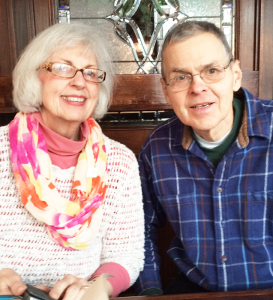Both professionals, regular folk reflect on how to age successfully
By Jenna Schifferle

Growing older can be difficult. With age comes new life transitions, health issues, and even loss. It can take time before someone accepts physical limitations or learns to cope with memory loss. Aging is an inevitable part of life, and there are certain challenges that arise with that.
So, what’s the secret to aging with grace?
According to Kenneth Garbarino, the medical director for the Geriatric Center of Western New York at Degraff Memorial Hospital, mindset and purpose are two major factors that come into play in the aging process.
“Growing old is tough. It’s about losses. Depending on your mindset, how you look at that sometimes dictates the quality of life you have,” Garbarino said.
At the Geriatric Center of Western New York, Garbarino and his staff focus on a holistic approach to elderly care. This includes a multidisciplinary focus on physical changes, psychological problems, social issues, and routine-of-daily-life needs. In conjunction with standard medical care, Garbarino’s staff helps patients learn to cope with their limitations. This may involve getting them connected to a Meals on Wheels program, or having a family member stop by to help the patient organize his or her medication.
Not everyone is fortunate enough to have a strong support system around them to help, he says.
“You’ve seen a movement where people used to live in the community, and they did their things locally. Their neighbors knew them. The shopkeepers knew them. What’s happened is a lot of people have kind of siloed themselves,” he said.
The most successful and resilient patients, he says, are the ones who are orderly with their treatment and care and handle the situation with laughter and gratefulness. On the other hand, when patients get depressed or feel alone, Garbarino says he tries to instill a sense of purpose in them. That may mean encouraging them to get a pet or finding an activity to keep their mind sharp.
“If you’re creative enough and you look out there, then there’s something that you can pick to try to challenge yourself so that when you get up in the morning, that’s your purpose,” he said.
At Elderwood at Cheektowaga, the nursing home staff strives to give patients a sense of purpose. They provide them with a full schedule of activities, from qigong,, an exercise class, to resident council, bowling, and musical performances.
Lisa Chamberlain, a registered nurse and supervisor at Elderwood, said people who participate in activities tend to get much more mental stimulation and do much better than those who don’t. They also thrive on companionship.
“People thrive when they have attention and compassion from other people,” she said.
In her own words
In her approximately 30 years of working as a visiting nurse for VNA Health Care and Kenmore Mercy, Mary Marquette did it all: blood work, wound care, therapy evaluations, errands, or just lending an open ear. During the winter, she would trek through the snow to assist patients in need, often late at night or on short notice — even during the Blizzard of ’77. She helped people from different backgrounds, with different lifestyles and personalities, varying needs and temperaments. Some had huge families, while others had no one. Some didn’t have a penny to their name, while others had countless resources.
Her most memorable patients were always the ones who lit up with glee despite their health issues and ailments, and gave thanks for their life. This always brought her a sense of wonder.
“I always thought it was good life training, you know?” she said.
Now, at age 76, Marquette finds herself on the opposite side of the equation, navigating new challenges in life. Some mornings, it can be a process to get out of bed. Other days, even small tasks can seem insurmountable. But, like her patients before her, Marquette always tries to focus on the positives.
“I think you have to try to find something to be grateful for, even if you have lots of problems. I think you need to not think so much what you don’t have, but what you do have. There’s a big connection between your mental outlook and your body,” she said.
For Marquette, an important part of aging has to do with having good friends. She can always count on her neighbors to help her out with tasks, and not a day goes by when she doesn’t call her friends multiple times. They check in with each other and love talking politics. During the summer, Marquette often sits on her porch and chats with people passing by.
If you’re lucky enough to get invited to her house to visit, Marquette might even offer you a bowl full of grapes, a hot cup of coffee, and a great conversation. She’ll tell you about her friends from the Philippines or maybe even show you the framed picture she has of her mantra: “Be Kind.”
“That’s an important thing with aging —– having good friends and keeping in contact. It’s important to have a sense of humor, too, because life ain’t easy,” she said, laughing.
Passion for teaching

For 75-year-old Linda Loomis, a Liverpool resident, community also means everything. By day, Loomis inspires young minds as a journalism and creative writing professor at SUNY Oswego. Though she’s been considering retirement for several years, there’s something about teaching that she loves and finds hard to leave behind.
“I really love the interaction with the students and being among young people to hear their ideas; to learn what’s important to them. I find that what I might perceive as really, really important doesn’t even register with them. But then, they know so much that I don’t,” she said.
Loomis works hard to stay connected to the people in her life and to stay up-to-date on the news happening around her. When she’s not teaching, Loomis engages herself with her love of music. She’s the classical music reviewer for the Syracuse Post-Standard, and she has recently taken up cello lessons with an old friend of hers. She even set a goal for herself, which was to master “Silent Night” by Christmas.
In addition to her blooming community life, Loomis also has a close family, including four grandchildren who have all entered their teenage years. She’s been married for 53 years to her husband Arthur, a thoughtful, caring man she met as a teenager. Together, she and Arthur have been together through all of life’s ups and downs, including his diagnosis of Alzheimer’s disease.
Now, Loomis a has become Arthur’s primary caregiver. She recalls the young years of courtship when “Art” was in the Navy, with love letters written back and forth.
“He’s always been the sweetest, most kind person in the world, and he remains that,” she said.
There are challenges that come with the condition, like having to speak more slowly and briefly to overcome Art’s aphasia. She also has to be stricter and has lost some of the flexibility in her schedule. Despite these challenges, the transition has allowed her to learn new things. Art was once in charge of the house, but everything home related has become her responsibility. She’s delved into learning about finances and organizing projects around the home.
Between the people in her life and her passion for learning, Loomis counts herself as lucky.
Her advice to others?
“Stay involved with people. Cherish your friends. Do things. Spend your money on experiences, not on things. Hold your friends dear, and stay close to your family,” she said.

